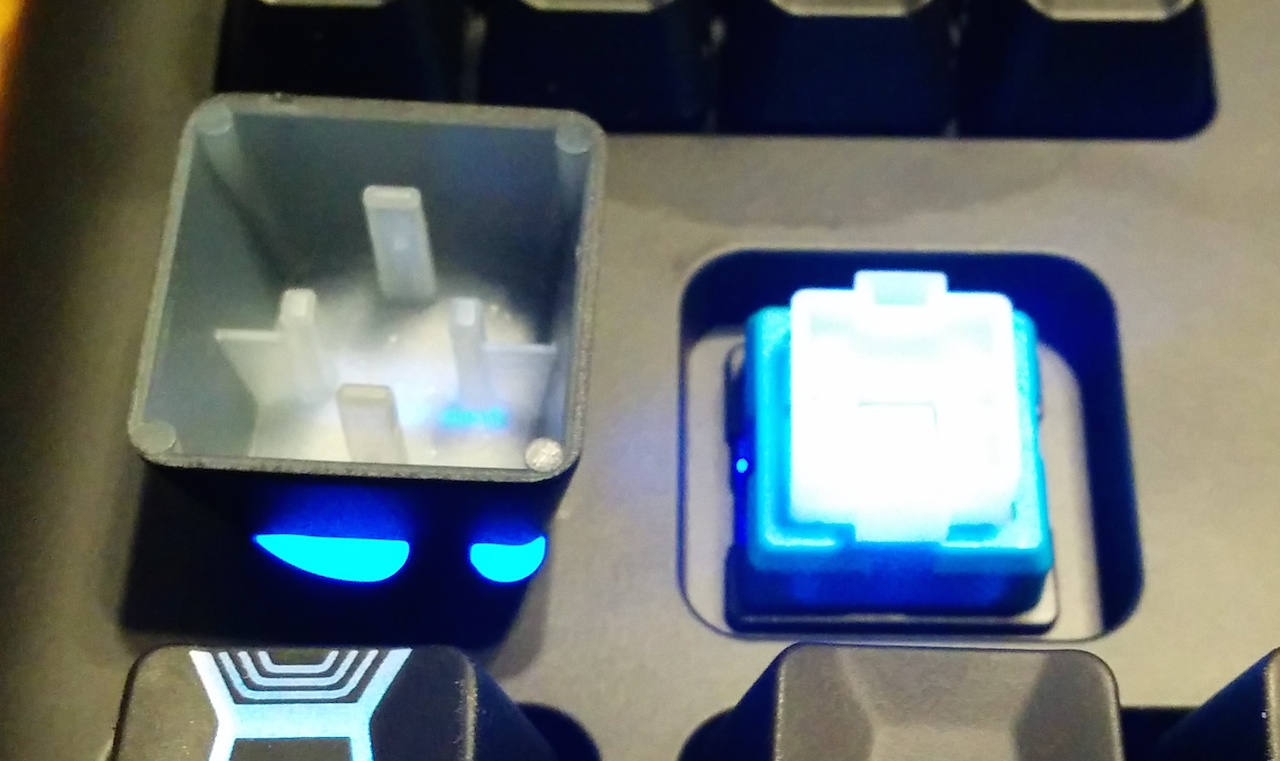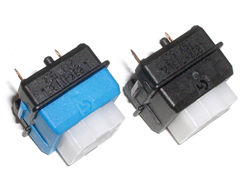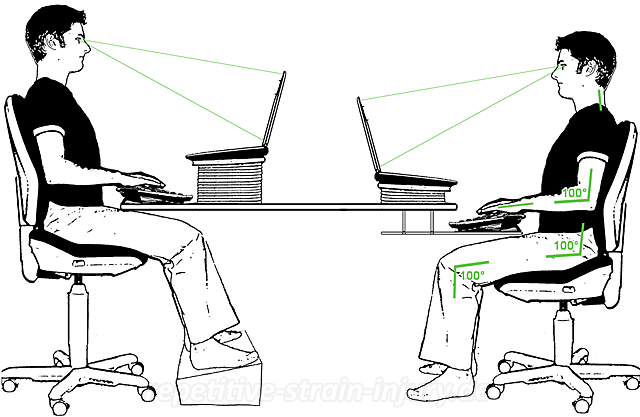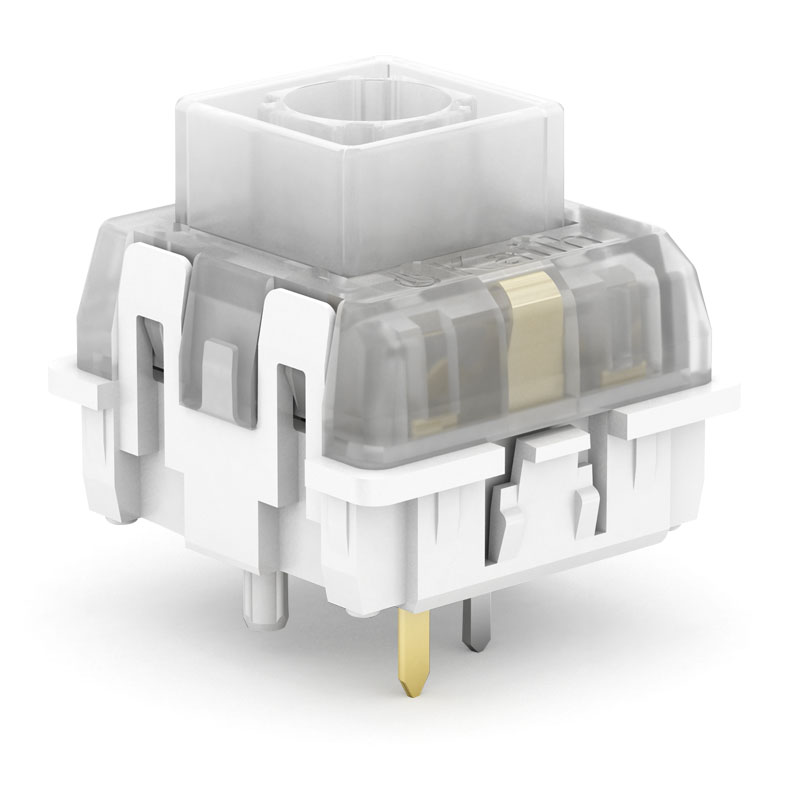Page 1 of 1
Ideal keycap mount?
Posted: 12 Jan 2020, 13:54
by squizzler
I am interested in whether there is an optimal design of interface by which the keycap is mounted on the switch.
The problem with MX and Alps is that the plug and socket by which the keycap mounts is directly over the switch mechanism. This creates what I would call additional 'stack height'. Thats's a bicycle terminology to describe the amount of height that the headset adds to the head tube and affects how low the handlebar stem can be placed.
Some low profile switches like Cherry ML and Kailh Choc use pairs of horizontally separated tabs which I presume straddle the central spring and enable the unit to be shorter.
I personally like the design Omron have produced for their RGB switch marketed as Alpha Zulu or Romer-G depending on vendor. This has four tabs arranged round the edges, with its wide stance it ought to be the most mechanically stable of all designs. The central void used as a light well as in present applications offers potential for a switch designer to house parts of the switch mechanism within the cap itself allowing for lower board profile, or permit more complex switch mechanisms like beamspring within a manageable stack height, albeit at expense of thru-switch lighting. Omron are one of the world's biggest microswitch manufacturers, doubtlessly know what they are doing, and presumably designed their interface with future potential in mind.
Whilst I am sure the first few responses will be along the lines of 'MX = industry standard, duh!', I am interested in what would be the optimal from an engineering point of view, and whether there are designs forum member particularly like.
Re: Ideal keycap mount?
Posted: 12 Jan 2020, 14:18
by anmq91
It depends on what you are going for. Is max stability more important than shine through lighting for example? Different very stable and interesting designs always have their pitfalls. The Buckling Spring (BS) design is super stable and I would assume the 'stacked height' would be negligible due to the lack of having an actual slider. It does however mean that you cannot have in/under key back lighting. In terms of stability I think the Fujitsu Leaf springs sliders are also super stable, but again have the lack of back lighting in keys. Romer G's have good stability and back lighting, but do not have the best reliability track record.
Would be interesting to hear the opinion of other more experienced members of the keyboard community here. I personally feel there is no such thing as a perfect interface - only the one that resonates best with the user for what they expect from the switch

Re: Ideal keycap mount?
Posted: 12 Jan 2020, 15:12
by Findecanor
I like these properties in switch sliders and mounts:
* Backlighting of Omron Romer-R, like you mentioned. I think that it would also be able to distribute light to legends that are in the corners instead of the middle. One thing I would like to see is the slider divided into two or more compartments, so that different legends on the same keycap could be illuminated by different LEDs depending on the keyboard's modifiers or other mode.
Also, I think the sliders should be opaque and black, with the inside painted white for containing and spreading the light only to the legend.
* Topre switches are not only very smooth and stable. Keys with short stabilisers don't have stabilisers directly under the key but instead as part of the slider underneath the mounting plate. This makes the stem even more stable so that no stabiliser mounts under a keycap are necessary. Also, the mechanism is protected.
On Topre Realforce, even the 1.75u Caps Lock is stabilised this way: and there wouldn't even be room for stabiliser mounts in the keycap. (BTW. On the HHKB, the corresponding key is not stabilised...)
* Some keyboards, such as IBM Buckling Spring keyboards implement stabilisation of longer keys by using two stems: one for a functioning switch and one for a dummy switch with no spring. This allows keys to be split into two by replacing a dummy with a real switch and changing keycaps. Thus, one single design of the underlying switch matrix/barrel plate/mounting plate is often able to support both ANSI, ISO and JIS (and HHKB etc.).
Many of these designs that depend only on a dummy switch are not very smooth though, and do suffer from binding on longer keys if they are not lubricated enough.
The
Ericsson switch has what I think is the best solution to this problem: there is a stabiliser bar, but it is connected between the two sliders: not connected to the keycap directly or via any special mounts.
* Some switches, such as Ericsson switches,
Space Invaders and Fujitsu Peerless have sliders with a wider flat top than e.g. Cherry MX and Alps.
This allows the switch to both have a longer spring (going up to the top) while not being too tall or needing to penetrate the PCB or backing plate.
(Edited for grammar)
Re: Ideal keycap mount?
Posted: 13 Jan 2020, 12:29
by squizzler
It depends on what you are going for. Is max stability more important than shine through lighting for example?
In my opinion, fastening to the inside-edge of the keycap improves on designs that use a central stem and socket in both these aspects.
In terms of stability I think the Fujitsu Leaf springs sliders are also super stable, but again have the lack of back lighting in keys. Romer G's have good stability and back lighting, but do not have the best reliability track record.
* Some switches, such as Ericsson switches, Space Invaders and Fujitsu Peerless have sliders with a wider flat top than e.g. Cherry MX and Alps.
This allows the switch to both have a longer spring (going up to the top) while not being too tall or needing to penetrate the PCB or backing plate.
It should be feasible to design switches with most of the above mentioned interfaces using a 'Romer-G' style mechanism that incorporates light wells. The ultimate would probably be for the slider to be an interference fit to the inside of the keycap without tabs and grooves but I suspect this would require tight tolerances to stay put and presumably also limits the opportunity to offer differently shaped keycaps.
Of the examples given I like the 'Space invader' since the ridge and groove in each corner would support the cap over the broadest area (like wheels on a car) and leave the greatest amount of internal space for the switch mechanism. The linked Wiki suggests the space invaders were successful in reducing stack height allowing the board as a whole to be less than 3/4 inch off the desk. That of the Fujitsu (Peerless, leaf spring Gen 3) also looks extremely elegant.
* Topre switches are not just very smooth and stable. Keys with short stabilisers don't have stabilisers directly under the key, but instead instead as part of the slider underneath the mounting plate. This makes the stem even more stable so that no stabiliser mounts for the keycap are not necessary. Also, the mechanism is protected.
On Topre Realforce, even the 1.75u Caps Lock is stabilised this way: and there wouldn't even be room for stabiliser mounts. (BTW. On the HHKB, the corresponding key is not stabilised...)
* Some keyboards, such as IBM Buckling Spring keyboards implement stabilisation of longer keys by using two stems: one for a functioning switch and one for a dummy switch with no spring. This allows keys to be split into two by replacing a dummy with a real switch and changing keycaps. Thus, one single design of the underlying switch matrix/barrel plate/mounting plate is often able to support both ANSI, ISO and JIS (and HHKB etc.).
Many of these designs that depend only on a dummy switch are not very smooth though, and do suffer from binding on longer keys if they are not lubricated enough.
The Ericsson switch has what I think is the best solution to this problem: there is a stabiliser bar, but it is connected between the two sliders: not connected to the keycap directly or via any special mounts.
I haven't yet considered stabilising the long keys as I run an ergonomic board whose long keys are only 1.5x that of letters.
In short, I feel those designs with central stem and socket such as MX and Alps mount are legacies from a time before backlighting or keyboard depth were even considered, and are sub-optimal for today's designs. I notice the Fujitsu leaf spring already mentioned here moved over the course of thee generations from a central stem with cruciform plug and socket to an inside-edge mount, suggesting that firm felt there were benefits to the latter.
Whilst I am sure the first few responses will be along the lines of 'MX = industry standard, duh!', I am interested in what would be the optimal from an engineering point of view, and whether there are designs forum member particularly like.
Thanks for proving me wrong there!
Re: Ideal keycap mount?
Posted: 19 Jan 2020, 13:28
by Findecanor
Another issue that should be taken into consideration is how easily it is to break a stem, either from external forces on a keyboard or from pulling a key.
Alps mount is relatively fragile. Longer stems also tend to be fragile.
Re: Ideal keycap mount?
Posted: 23 Jan 2020, 05:05
by Man_In_Blue
As far as stability, HiTek space invaders have just about the most stable mount I have ever felt. I also quite like the Micro-Switch hall effect mount, as it allowed for a cap to be nearly solid.
Re: Ideal keycap mount?
Posted: 27 Jan 2020, 13:14
by squizzler
Slightly funny thing about the Omron B3K series (Romer-G, Gamma Zulu) is that the mounting tabs in the keycaps have ribs that support the caps some distance above the slider. This is interesting because it implies that the currently available keycaps increase the stack height to where it would sit if it had MX mount. In other words they have bastardised the keycap design to keep the stack height where it would be if it had to accommodate MX mount and with appropriate short skirt keycaps that omit the ribs they would sit by my estimation half a centimetre lower.
Now look at the low profile Cherry MX. They seem to sit low but on closer examination they cheat by hiding a lot of their height in a long barrel protruding through the PCB - whose depth closely mirrors the height taken up by the central stem. With the correct keycaps Omron could position the B3K directly against the LP MX as a low profile switch with full travel. I think this conclusively illustrates the advantage of fastening round the periphery rather than centre which is not exclusive to B3K but also would make life easier for those designing around space invader and other edge/corner mounts.

(image = bhtooefr)

(DT Wiki)

(Cherry)
Re: Ideal keycap mount?
Posted: 27 Jan 2020, 13:57
by Findecanor
squizzler wrote: 27 Jan 2020, 13:14
... with appropriate short skirt keycaps that omit the ribs they would sit by my estimation half a centimetre lower.
The Omron's keycaps would then have to be wider at the top because the switch is so wide where the slider goes into the top housing. The Cherry MX's top housing is shaped like a truncated pyramid so that a traditionally-shaped keycap would fit over it with some clearance. A thick-walled Cherry-profile keycap can even
hit the switch housing when the switch is in the wrong orientation.
Only thin-walled MX keycaps fit over Cherry MXLP, and keycaps of lower height made especially for MXLP tend to have the bottom of the skirt higher up.
squizzler wrote: 27 Jan 2020, 13:14They seem to sit low but on closer examination they cheat by hiding a lot of their height in a long barrel protruding through the PCB
The point is to have a long spring, to make it resemble the feel of the Cherry MX as much as possible.
Cherry
could have done like Kailh and put a stabiliser bar there instead, but when you have a barrel through the PCB anyway...
Re: Ideal keycap mount?
Posted: 27 Jan 2020, 17:53
by SneakyRobb
anmq91 wrote: 12 Jan 2020, 14:18
The Buckling Spring (BS) design is super stable and I would assume the 'stacked height' would be negligible due to the lack of having an actual slider.
It does however mean that you cannot have in/under key back lighting.
Challenge accepted.
Re: Ideal keycap mount?
Posted: 01 Feb 2020, 11:35
by squizzler
I found a page in the Wiki withe the
various types of mount listed. The terminology for my favoured design is 'snap on', apparently.
Findecanor wrote: 27 Jan 2020, 13:57
squizzler wrote: 27 Jan 2020, 13:14
... with appropriate short skirt keycaps that omit the ribs they would sit by my estimation half a centimetre lower.
The Omron's keycaps would then have to be wider at the top because the switch is so wide where the slider goes into the top housing. The Cherry MX's top housing is shaped like a truncated pyramid so that a traditionally-shaped keycap would fit over it with some clearance. A thick-walled Cherry-profile keycap can even
hit the switch housing when the switch is in the wrong orientation.
Only thin-walled MX keycaps fit over Cherry MXLP, and keycaps of lower height made especially for MXLP tend to have the bottom of the skirt higher up.
As you imply it would be a compromise to reduce the height, but a trade off that I feel would be worth making so that we can have switches with the throw and weighting of traditional sorts but a more ergonomic height. Perhaps the
XDA keycap profile would work?
One implication with the Omron B3K (Romer-G etc) is that unlike Cherry the keycap cannot be mounted in 90deg increments, although I am not sure in how many cases this would cause a problem.
My main interest with a better mount is that the height of the board can be reduced, or alternatively that esoteric mechanisms could be housed in switches of the same height as currently. Looking for instance at the Beamspring, Input Club have engineered a version that fits in the Cherry MX chassis. Yet if you
look at their page the force charts for their product and that for the IBM (they have kindly placed both together), it is clear that they vary considerably. And the author says as much that the MX mount compromises the design:
Next — keycaps! In our opinion, Cherry MX keycap mounts aren’t an optimal design. They are the keycap standard, though, so we’re working around them in our projects so you can keep using fancy keycap sets with our keyboards. The main challenge of integrating a beam spring switch is actually having enough room to place the beam and tensioner somewhere inside the confines of a Cherry MX-sized housing. The keycap mount plays a role in this, as it must fit inside the switch when pressed.
So there you have it. Perhaps there is space for a community born 'open standard' alternative to the MX. Whilst I feel the Omron B3K is probably the best of the mount designs in current production, I think that an even better design is possible.
Re: Ideal keycap mount?
Posted: 04 Mar 2020, 10:27
by squizzler
Whatever happened to the
Kailh KO family? It has a hollow "light well" stem just like the Omron B3K, and stem that looks to incorporate Kailh's "Box" design. it seems to have arrived as a competitor to the Omron, so presumably able to refine on the design of the latter.
Best of all there is a click version available, something that Omron never achieved in their B3K.
I gather it is used in various Azio retro keyboards, so this newest of all keycap mounts might rather ironically be limited to caps that look like those available over a century ago!
Re: Ideal keycap mount?
Posted: 04 Mar 2020, 11:45
by Findecanor
A lower-profile brother to that one seems to have been adopted as the
SteelSeries QS1. 3.0 mm travel instead of 3.6.
Re: Ideal keycap mount?
Posted: 04 Mar 2020, 12:16
by squizzler
Are you sure the KO preceded the SteelSeries rather than the other way round? The wiki on the KO dates from 2017 and that for the SteelSeries is two years older. Also the article claims the Steelseries unit is based on a "1583" series and the KO is "1593" series, and the KO's debut board - AFAIK - was the Azio Retro.
The shape differs a lot between the two, and the mount appears incompatible, with the KO using a square with cutouts in the corners (or perhaps a very fat cross) with circular hole through the middle, this sitting within a "box" slider. On the SteelSeries the "box" slider *is* the mount.
Re: Ideal keycap mount?
Posted: 05 Mar 2020, 08:30
by squizzler
ntv242 wrote: 04 Mar 2020, 16:46
The assumption here is that stack height is not good. Why is that?
All other things being equal, it is better for the keyboard to be lower to the desk. We may look at youtube reviews of classic keyboards and think that your board needs to be unmanageably bulky to be taken seriously, like those motorists now clogging up the streets with their ridiculously oversized off-road vehicles (I believe they are known as SUVs in the motoring community) in lieu of normal cars that would do the job more efficiently.
It is never going to be possible to make a beam spring that is as thin as an Apple aluminium board of course, but the design of the mount adds unnecessary height. Conversely, Cherry MX apparently came about due to the German Standards institute mandating lower overall height than before.
Re: Ideal keycap mount?
Posted: 05 Mar 2020, 11:57
by kbdfr
squizzler wrote: 05 Mar 2020, 08:30[…] All other things being equal, it is better for the keyboard to be lower to the desk. […]
"
All other things being equal"?
As long as your hands hover over the keyboard (like they should), its actual height is completely irrelevant.

Re: Ideal keycap mount?
Posted: 05 Mar 2020, 13:51
by squizzler
It is hardly surprising so many of us suffer ergonomic issues - the above diagram appears to suggest the edge with the F-keys should be facing the user.

The space invader is getting a lot of votes, and it does look like it affords the switch designer the options to put more of the mechanism inside the cap (liberating space to provide a more sophisticated mechanism for typists) or to hollow out the middle to form a light well (a pretty option for gamers).
I increasingly like the look of the Kailh KO due to its light-well and apparent design cues (that square shroud) from the highly regarded Box switch. The inner mount is - if you squint hard enough - actually an evolution of the tried and true cross shaped stem beefed up so much as to become almost square except for a small notch in each corner.

Re: Ideal keycap mount?
Posted: 05 Mar 2020, 14:32
by Findecanor
kbdfr wrote: 05 Mar 2020, 11:57
squizzler wrote: 05 Mar 2020, 08:30[…] All other things being equal, it is better for the keyboard to be lower to the desk. […]
"
All other things being equal"?
As long as your hands hover over the keyboard (like they should), its actual height is completely irrelevant.
I'd say that the actual issue is distance between your wrists and your thighs.
Ideally, you should be able to type with the keyboard practically in your lap, but without it
resting on your lap. Stupidly designed desks are just as much of a problem as thick keyboards.
Notice that the guy in your figure is scraping his leg against the edge of the desk....
Desks with bars underneath the desk surface are the worst.
 (DT Wiki)
(DT Wiki) (Cherry)
(Cherry)
